

Back in 2007, When Marshall Foxworthy and I Showed Noel Bangert The Racing Program – He Immediately Recognized His Design Inspiration.
Hi Gang…
Noel Bangert was one special guy – and a talented designer too. I’ll share another article on design he penned back in the 1950’s in the near future, and you’ll see what I mean that he was an artist first – above all else. Like I said….one special guy.
When I was interviewing Noel about the design of his cars, he mentioned that he was inspired by two different cars when he was designing the Bangert Manta Ray – the second version of his famous Bangert bodied sports cars. The inspiration for the Manta Ray design were:
* The 1954 Buick Wildcat II concept car
* And a special bodied Chrysler Maserati racecar he saw tearing up the tracks in the early to mid 1950’s
I finally found more information about the “special bodied racecar” that inspired him, and the story of its build is quite amazing.
Why Design Heritage is Important:
With the help of Erich Schultz and Guy Dirkin, I recently wrote a series of articles on the design heritage of the Glasspar G2 and the Victress S1. Click here to read this series of articles. Today’s article is on the design heritage of the Bangert Manta Ray, and focuses only on the race car that inspired it. In a future story, I’ll share with you more about the very special concept car – the Buick Wildcat II (also created in fiberglass), which also influenced the design of Bangert’s Manta Ray.

Here’s A Front Shot Of A Recently Discovered Bangert Manta Ray. The Similarity Of The Front Ends Is Striking (And Beautiful). It’s Always Looked Like A Concept Car To Me.
As you recently heard from Elwood Cauffman…..he reminded us that there was no such thing as a “kit car” in the 1950’s. And he would know – he built one from scratch. Click here to review this story on Elwood’s Bangert. Typically, you would buy the body and build the rest. And the bodies were pieces of art themselves. For the most part, unique designs inspired by famous contemporary show cars or inspired by the times – rarely if ever a “clone” of another car (the Allied Swallow, not withstanding).
So today, if you want to restore and drive a car that is nearly as rare as a GM Motorama concept car – look to the 1950’s fiberglass specials. Most of them even appeared at their own Motorama sponsored by Petersen Publishing – and were nearly as famous as their contemporary GM show cars too.
It’s just that our car culture has forgotten these hidden gems of the past, and the next one can be yours.
So….put on your driving gloves, get your goggles, and fasten your five-point harness. You’re about to be amazed by the design and performance of one special car. The Kopecky Chrysler Maserati Special. One of two special cars that was the inspiration for Noel Bangert’s Manta Ray.
Red Hot Retread (Car Craft, May 1954)
The Maserati That Raced Again
By John Christy
Photos by Rick
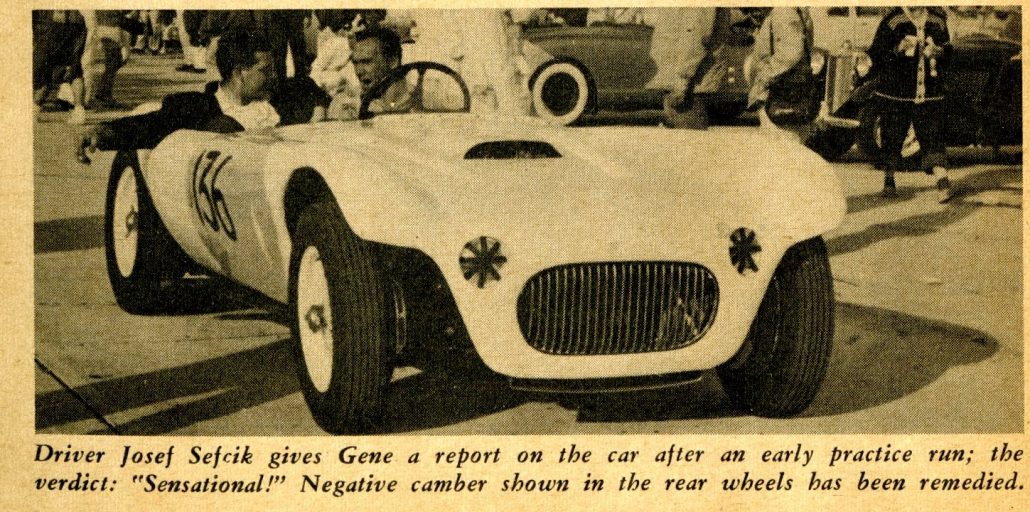
Here’s The 1954 Chrysler Maserati Special – Formerly The 1937 Topping Special That Ran At The Indianapolis 500.
Road racing, like other forms of automotive sport, is getting more highly competitive each month. Cars that were champions a year ago are fast becoming “also-rans” as each race meet goes into history. Part of this can be attributed to hot rodders moving into this field of activity. People are no longer satisfied to tell the dealer to wrap up a car and then dump it directly on a race course.
Part can also be attributed to the manufacturers of the heftier breeds who are bolting together faster and faster equipment. If one has 10 to 15 thousand dollars rattling around in one’s pants pocket the problem is easily solved. One just writes to Enzo Ferrari or Mercedes and says “build me a race car.”
If one hasn’t this kind of scratch, what then?
There’s only one answer: build it yourself. However, this also poses problems. Building a chassis to stick to the road under the kind of power that gets pumped through today’s hot rodded engines can be a tough exercise in engineering – and an expensive one.
The neatest solution to this that we’ve yet seen is the answer which Gene Kopecky of San Diego California came up with. Gene didn’t have the equipment, time, or money to build a chassis that would give him any kind of a chance in the engine class in which he wanted to run. However, on a trip to Los Angeles about a year ago, he came across a Type R1 Formula Maserati chassis that had run in 1937 at Indianapolis as the “Topping Special” and more recently, had failed to qualify when entered as one of the Grancor team in 1949.
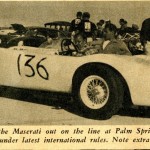
The Back End Styling Of The Chrysler Maserati Special Did Not Match The Back End Styling of The Bangert Manta Ray. Noel Used Only The Front and Sides As His Guide.
Since that time, the chassis had been stripped of body, engine, and rear brakes as it passed among several owners. This particular type of race car had been built under the 750 kilogram formula of the thirties which stated that a Grand Prix car must weigh less than 1657 lbs when stripped of tires, fuel, and all liquids. This formula was put into effect by the FIA in an attempt to limit the tendency toward huge machines that were then in vogue.
The rule backfired, however. Builders made their chassis super-light, saving the weight allowance for tremendous engines. The result was that the chassis were actually years ahead of their time in design. One result was the fabulous Mercedes car that swept competition like the plague in the years just prior to World War II.
Another was the set of four Maseratis built for Indianapolis competition. It was in one of these, the Boyle Special, that Wilbur Shaw pulled his two-in-a-row act at Indianapolis. And it was a mate to this car that Gene discovered rotting away in Los Angeles.
Here was a ready made chassis of superior or at least equal design to the best and most expensive foreign sports cars running today. It had one great advantage besides this – it could be acquired without going into hock for life. Gene lugged the car, or what was left of it, back to San Diego and set to work. Completely stripping the chassis, he and two others, Bob Jackson and Dean Meltzer, replaced every worn bearing and moving part in the car with standard metric replacements.
Since the rear brakes were missing, Gene took a pattern from the cast alloy front brakes and had a new set cast, this being the one major-expense item of the whole deal. After refurbishing the chassis, the boys set to work on a big, wooly Chrysler. This was bored out to four inches, giving a displacement of 364.4 cubic inches. The flywheel was machined from a chunk of 75 ST alloy and fitted with the standard Chrysler ring gear and a Friction Master clutch.
The heads were given the big valve treatment, 1 15/16thof an inch on the intakes and 1 and ¾ on the exhausts; the ports were opened up to match. Compression was boosted to 9 to 1 with a set of high-dome Jahns pistons. A Herbert 285 roller tappet cam was fitted and the entire assembly was balanced. Stuffed onto a dynamometer, this bear was putting out 250 horsepower at 5500 rpm when the mains let go.

Here You Can See The Styling Design From a Side Profile of the Bangert Manta Ray. Wheelbase Is 100″.
The whole balancing procedure was gone through again and new main caps were punched out of heavy blocks of cold-roll steel. This time it held together on a short run-in. The engine was then adapted with a motor plate to the Maserati bell housing and remote, rear-end mounted gearbox. The nice thing about this arrangement is that the drive shaft rotates at the same speed (engine rpm) in all gears.
One big feature widely hailed today as “the latest thing” is the ball-joint front suspension which dispenses entirely with kingpins. These ball-joints are fully adjustable by means of threaded and keyed sockets, going the “modern” manufacturers one better.
The front torsion bars were originally designed to be adjustable by means of threaded clamps at their fixed ends but for reasons which will become apparent later, this is now being changed to the more modern method of using a small splined arm and set screw arrangement similar to that of Kurtis.
Aside from this, the only other change made in the suspension was the addition of an extra leaf in the rear springs to take care of the extra weight added by the switch from track car to sports car. The reason for this change, Gene says, is that under heavy acceleration the car develops a definite negative camber effect at the rear end which has a tendency toward tire slippage. The extra leaf eliminates this fault.
Meltzer, meanwhile, was building an aluminum body for the car. No jigs or expensive dies were used; the whole thing was laboriously pounded out by eye and hand alone – strictly a labor of love. The Palm Springs race was coming up and there was no time to waste. No more dyno checks, no time for anything but assembly.
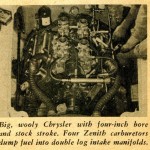
Caption: Big, Wooly Chrysler WithFour-Inch Bore and Stock Stroke. Four Zenith Carburetors Dump Fuel Into Double Log Intake Manifolds.
On final assembly, it was discovered what was meant by the “55-45 Formula.” Complete with driver and fuel, 55 percent of the weight was on the independently sprung rear end, 45 percent on the torsion bar suspended front end. This was considered close to the ideal during the time that Grand Prix racing was in its prewar heyday. Although the modifications done by Gene and his crew had raised the weight of the car to 2200 lbs., the balance had been changed not a whit.
Came race day at Palm Springs. The car was put on the course for practice with Josef Sefcik, another member of the crew, who had previously raced motorcycles in Czechoslovakia, as driver. The car exceeded Gene’s fondest hopes, going through the turns as if it were on rails and accelerating like a dragster.
Top speed was approximately 145 with the 3.385 gearing in the rear end. During the race itself, the car lapped at a reported two minutes, 18 seconds. One unforeseen circumstance forced the car out after five laps – the front torsion bars slipped in their mounts causing the car to dive. The eventual winner of the race was Sterling Edwards in a 4.1 Ferrari in which he lapped the course at two minutes and 20 seconds.
Total cost of the Chrysler Maserati as estimated by Gene was slightly under $4000, about one-third the cost of a 4.1 Ferrari or similar car and about equal to the price of a good track roadster! When talking to Gene later, he pointed out that while there are only three other Type R1 Maseratis like his, there are several hundred race cars of middle and late 1930 and middle 1940 vintage, other types of Maserati, Alfa Romeo, Sparks, Miller, and even a 750 Kg Mercedes, still unfound in garages and shops around the country.
These cars have been honorably retired from championship racing and rest unused. While unsuited for professional racing, they still can form the basis for sports cars which can be made the equal of the best running today through the use of hot rod practices and at far less expense than would be required for the hotter varieties.
All it requires is a little perseverance.
Go man!
Summary:
Recently I spoke to automotive historian Jim Sitz about the fate of the Chrysler Maserati special. It survived and is being brought back to its original 1930’s configuration by a collector in Southern California. It’s not being restored to it’s 1950’s special configuration, but that would be a neat body to save – if it still existed.
But….how many specials are still out there with magnificent “lost” chassis clothed by a beautiful fiberglass body? Have you read the story about the Devin bodied Ferarri? If not, click here for the full story. You could be the next one to find the missing lost car from the golden racing years with the million dollar chassis.
But if you find one of these lost “gems”….I get first dibs on the fiberglass body you’ll be taking off it!
*wink*
Hope you enjoyed the story, and until next time…
Glass on gang…
Geoff
——————————————————————-
Click on the Images Below to View Larger Pictures
——————————————————————-
- Back in 2007, When Marshall Foxworthy and I Showed Noel Bangert The Racing Program – He Immediately Recognized His Design Inpiration.
- Here’s A Front Shot Of A Recently Discovered Bangert Manta Ray. The Similarity Of The Front Ends Is Striking (And Beautiful). It’s Always Looked Like A Concept Car To Me.
- Here You Can See The Styling Design From a Side Profile of the Bangert Manta Ray. Wheelbase Is 100″.
- Here’s An Ad That Appeared For The Bangert Manta Ray in Motor Life Magazine, February 1956.
- The Back End Styling Of The Chrysler Maserati Special Did Not Match The Back End Styling of The Bangert Manta Ray. Noel Used Only The Front and Sides As His Guide.
- Here’s The 1954 Chrysler Maserati Special – Formerly The 1937 Topping Special That Ran At The Indianapolis 500.
- Caption: Big, Wooly Chrysler With Four-Inch Bore and Stock Stroke. Four Zenith Carburetors Dump Fuel Into Double Log Intake Manifolds.
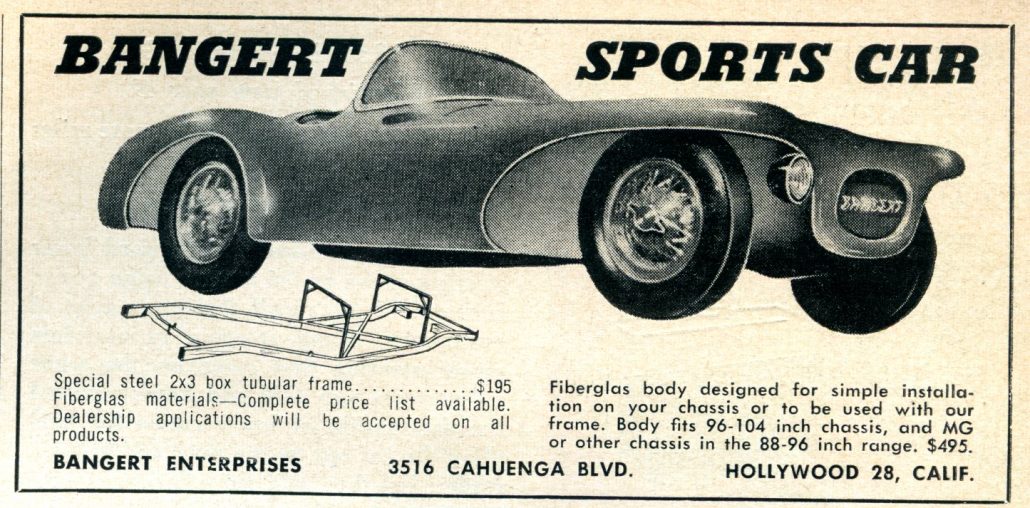











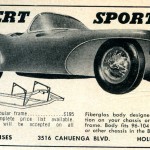
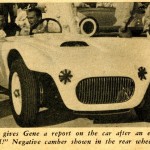
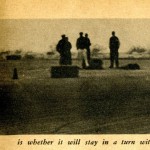
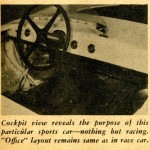

This site is protected by reCAPTCHA and the Google Privacy Policy and Terms of Service apply.